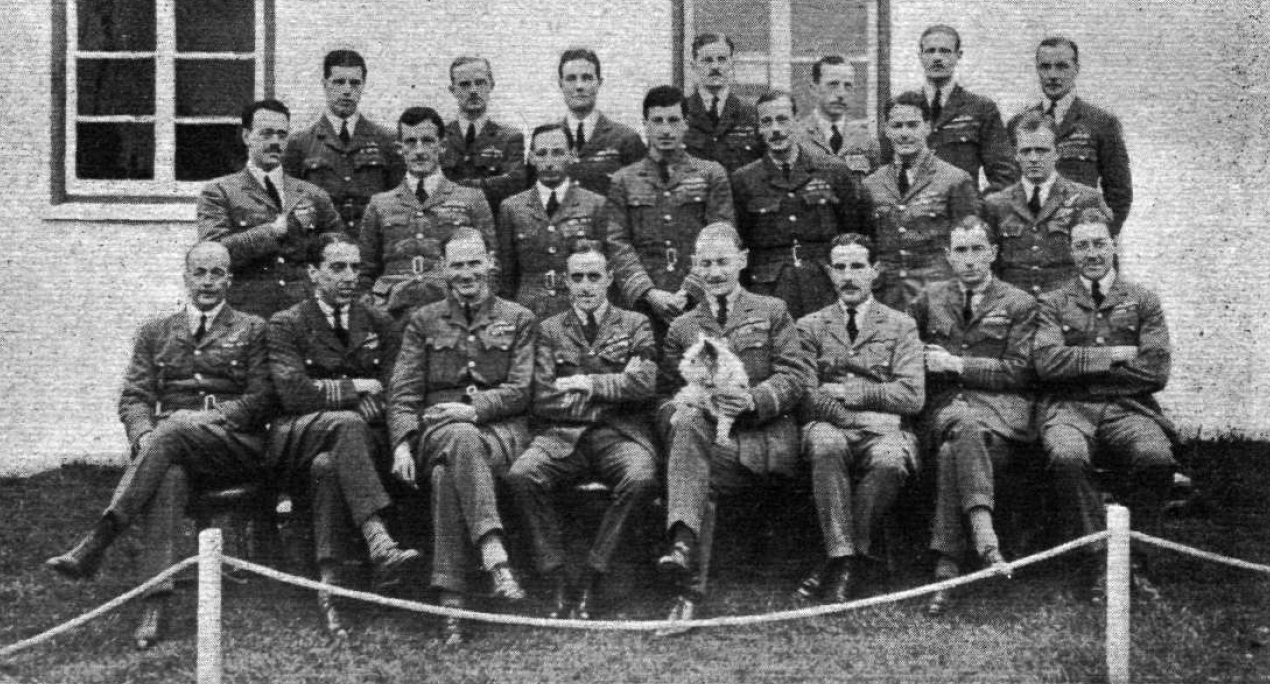|
Minoo Merwan Engineer
Air Marshal Minoo Merwan Engineer, PVSM, MVC, DFC (1 December 1921 – 31 December 1997) was a former Air Officer in the Indian Air Force. He is one of the most decorated officers in the Indian Air Force, with the second-highest civil decoration - the Padma Bhushan, two gallantry awards - the Maha Vir Chakra and the Distinguished Flying Cross, and the highest peace-time distinguished service award - the Param Vishisht Seva Medal. His elder brother, Air Marshal Aspy Engineer served as the 4th Chief of the Air Staff. Early life Engineer was born Aspy Merwan Irani on 1 December 1921 in Lahore, Punjab Province, British India to Meherwan Irani and Maneckbai. Meherwan was a Divisional Engineer for the North Western Railway,. His interest in mechanics led his friends to rename him Engineer. He was the sixth amongst eight siblings - two girls and six boys. His brothers, Aspy, Jungoo and Ronnie, also joined the Indian Air Force, while another brother, Homi, joined the Indian Army. ... [...More Info...] [...Related Items...] OR: [Wikipedia] [Google] [Baidu] |
Indian Air Force
The Indian Air Force (IAF) is the air arm of the Indian Armed Forces. Its complement of personnel and aircraft assets ranks third amongst the air forces of the world. Its primary mission is to secure Indian airspace and to conduct aerial warfare during armed conflict. It was officially established on 8 October 1932 as an auxiliary air force of the British Empire which honoured India's aviation service during World War II with the prefix ''Royal''. After India gained independence from United Kingdom in 1947, the name Royal Indian Air Force was kept and served in the name of Dominion of India. With the government's transition to a Republic in 1950, the prefix ''Royal'' was removed. Since 1950, the IAF has been involved in four wars with neighbouring Pakistan. Other major operations undertaken by the IAF include Operation Vijay, Operation Meghdoot, Operation Cactus and Operation Poomalai. The IAF's mission expands beyond engagement with hostile forces, with the IAF particip ... [...More Info...] [...Related Items...] OR: [Wikipedia] [Google] [Baidu] |
Training Command (India)
Training Command is the Indian Air Force's command responsible for flying and ground training. In the 1930s, the approaching threat and later advent of World War II and the leaning of Japan towards the Axis powers, the latter was considered as a potential enemy. Therefore, need was felt to make IAF a self-supporting force for the South Eastern Theatre of war. This led to the rapid expansion of the IAF. A target was fixed of 10 IAF Squadrons. With this expansion, the requirement of pilots and technical personnel increased. For the training of technical personnel, a technical training school was set up at Ambala in 1940. In a 1949 reorganisation of the Indian Air Force, while frontline units were put under the Operations Command, all the training institutions were placed under the jurisdiction of the Training Command. Among Training Command's units is the Navigation Training School at Begumpet Air Force Station, Hyderabad. It flies the BAe HS. 748,Dutch Aviation SocietyIndia ... [...More Info...] [...Related Items...] OR: [Wikipedia] [Google] [Baidu] |
RAF Staff College, Andover
The RAF Staff College at RAF Andover was the first Royal Air Force staff college to be established. Its role was the training of officers in the administrative, staff and policy aspects of air force matters. History Foundation Following the foundation of the RAF in April 1918 and the end of the First World War in November 1918, there was a determination to maintain the Air Force as an independent service rather than let the Army and Royal Navy control air operations again. Therefore, the creation of an RAF Staff College to parallel the Army Staff College and the Royal Naval Staff College was an important element in fully establishing the RAF. On 14 November 1921, Air Commodore Robert Brooke-Popham was tasked with setting up the RAF Staff College. On 1 April the following year, the new RAF Staff College came into being with Brooke-Popham as its first commandant. The Staff College was based at RAF Andover and was subordinate to Inland Area. The dog seen in the photograph on R ... [...More Info...] [...Related Items...] OR: [Wikipedia] [Google] [Baidu] |
Commanding Officer
The commanding officer (CO) or sometimes, if the incumbent is a general officer, commanding general (CG), is the officer in command of a military unit. The commanding officer has ultimate authority over the unit, and is usually given wide latitude to run the unit as they see fit, within the bounds of military law. In this respect, commanding officers have significant responsibilities (for example, the use of force, finances, equipment, the Geneva Conventions), duties (to higher authority, mission effectiveness, duty of care to personnel), and powers (for example, discipline and punishment of personnel within certain limits of military law). In some countries, commanding officers may be of any commissioned rank. Usually, there are more officers than command positions available, and time spent in command is generally a key aspect of promotion, so the role of commanding officer is highly valued. The commanding officer is often assisted by an executive officer (XO) or second-in-com ... [...More Info...] [...Related Items...] OR: [Wikipedia] [Google] [Baidu] |
Squadron Leader
Squadron leader (Sqn Ldr in the RAF ; SQNLDR in the RAAF and RNZAF; formerly sometimes S/L in all services) is a commissioned rank in the Royal Air Force and the air forces of many countries which have historical British influence. It is also sometimes used as the English translation of an equivalent rank in countries which have a non-English air force-specific rank structure. An air force squadron leader ranks above flight lieutenant and immediately below wing commander and it is the most junior of the senior officer ranks. The air force rank of squadron leader has a NATO ranking code of OF-3, equivalent to a lieutenant-commander in the Royal Navy or a major in the British Army or the Royal Marines. The equivalent rank in the Women's Auxiliary Air Force, Women's Royal Air Force (until 1968) and Princess Mary's Royal Air Force Nursing Service (until 1980) was "squadron officer". Squadron leader has also been used as a cavalry command appointment (UK) and rank (France) since ... [...More Info...] [...Related Items...] OR: [Wikipedia] [Google] [Baidu] |
Arakan (other)
Arakan is a historical region of Burma. Arakan may also refer to: *Arakan Division, a British colonial division *Rakhine State, a province of Myanmar *Arakan Mountains, Myanmar *Arakanese people **Arakanese Indians **Arakanese language, a former Tibeto-Burmese language, now split into two distinct languages: Rakhine language, Rakhine and Marma language, Marma *Arakan Campaign 1942–43, a campaign during World War II *Arakan, Cotabato, Philippines *Arakan River, Philippines See also *Arakanese (other) *Rakhine (other) *Rakan (other) {{Disambiguation, geo ... [...More Info...] [...Related Items...] OR: [Wikipedia] [Google] [Baidu] |
Burma
Myanmar, ; UK pronunciations: US pronunciations incl. . Note: Wikipedia's IPA conventions require indicating /r/ even in British English although only some British English speakers pronounce r at the end of syllables. As John Wells explains, the English spellings of both Myanmar and Burma assume a non-rhotic variety of English, in which the letter r before a consonant or finally serves merely to indicate a long vowel: �mjænmɑː, ˈbɜːmə So the pronunciation of the last syllable of Myanmar as ɑːror of Burma as ɜːrməby some speakers in the UK and most speakers in North America is in fact a spelling pronunciation based on a misunderstanding of non-rhotic spelling conventions. The final ''r'' in ''Myanmar'' was not intended for pronunciation and is there to ensure that the final a is pronounced with the broad ''ah'' () in "father". If the Burmese name my, မြန်မာ, label=none were spelled "Myanma" in English, this would be pronounced at the end by all ... [...More Info...] [...Related Items...] OR: [Wikipedia] [Google] [Baidu] |
World War II
World War II or the Second World War, often abbreviated as WWII or WW2, was a world war that lasted from 1939 to 1945. It involved the vast majority of the world's countries—including all of the great powers—forming two opposing military alliances: the Allies and the Axis powers. World War II was a total war that directly involved more than 100 million personnel from more than 30 countries. The major participants in the war threw their entire economic, industrial, and scientific capabilities behind the war effort, blurring the distinction between civilian and military resources. Aircraft played a major role in the conflict, enabling the strategic bombing of population centres and deploying the only two nuclear weapons ever used in war. World War II was by far the deadliest conflict in human history; it resulted in 70 to 85 million fatalities, mostly among civilians. Tens of millions died due to genocides (including the Holocaust), starvation, ma ... [...More Info...] [...Related Items...] OR: [Wikipedia] [Google] [Baidu] |
North Western Railway (British India)
The North Western State Railway (NWR) was formed in January 1886 from the merger of the Scinde, Punjab & Delhi Railway, the Indus Valley State Railway, the Punjab Northern State Railway, the eastern section of the Sind–Sagar Railway and the southern section of the Sind–Pishin State Railway and the Kandahar State Railway. History The military and strategic concerns for securing the border with Afghanistan were such that, Francis Langford O'Callaghan (who was posted from the state railways as engineer-in-chief) was called upon for a number of demanding railway projects, surveys and constructions in the Northwest Frontier.Institution of Civil Engineers "Biographical Dictionary of Civil Engineers in ... [...More Info...] [...Related Items...] OR: [Wikipedia] [Google] [Baidu] |
British India
The provinces of India, earlier presidencies of British India and still earlier, presidency towns, were the administrative divisions of British governance on the Indian subcontinent. Collectively, they have been called British India. In one form or another, they existed between 1612 and 1947, conventionally divided into three historical periods: *Between 1612 and 1757 the East India Company set up Factory (trading post), factories (trading posts) in several locations, mostly in coastal India, with the consent of the Mughal emperors, Maratha Empire or local rulers. Its rivals were the merchant trading companies of Portugal, Denmark, the Netherlands, and France. By the mid-18th century, three ''presidency towns'': Madras, Bombay and Calcutta, had grown in size. *During the period of Company rule in India (1757–1858), the company gradually acquired sovereignty over large parts of India, now called "presidencies". However, it also increasingly came under British government over ... [...More Info...] [...Related Items...] OR: [Wikipedia] [Google] [Baidu] |






